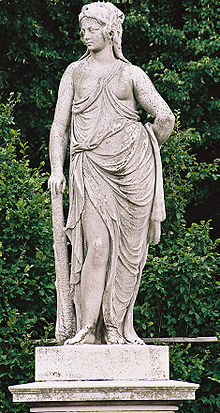Omphale

Omphale ( Greek Ὀμφάλη ) is a figure in Greek mythology . She was the daughter of Iardanos and, as the widow of Tmolos, Queen of Maeonies ( Lydia ).
She is mainly known in connection with Heracles . This had to serve as atonement for the murder of Iphitus as a slave and was bought by Omphale. According to some sources, he served her for a year, according to others, for three years. During this time, Heracles punished robbers who made his mistress' land unsafe and defended it against invading enemies. When the queen found out who the slave was, she married him. Two or three sons are named (Lamos, Agelaos , Tyrsenos). In a blind love for her and effeminate through luxuriant life, the hero condescended to put on women's clothes, spin wool and do other women's work, while she wore his lion skin and the wooden club. When the time of punishment was over, the hero realized his delusion and left Omphale.
The main features of the myth are proven as early as the 5th century BC, not unexpectedly in satyr play and comedy , but the interchanging of the robes has only been found since the 1st century BC. BC, especially among the Romans ( Ovid , Properz , Seneca ). The obvious mockery of - allegedly - effeminate men is already palpable for Perikles / Aspasia (Plutarch, Perikles 24), then especially in Augustus' propaganda against Mark Antony / Cleopatra (Plutarch, Antonius 90.4).
Omphale in art
- Lucas Cranach the Elder and Lucas Cranach the Younger : Hercules at Omphale , numerous depictions
- Peter Paul Rubens : Hercules and Omphale (around 1606), Musée du Louvre , Paris
- Bartholomäus Spranger : Hercules near Omphale (around 1585), Kunsthistorisches Museum , Vienna
- Gotthold Ephraim Lessing : Hercules and Omphale. Dialog (around 1778; first published in 1796)
- Théophile Gautier : Omphale or The Carpet Lady in Love, a Rococo story. Novella (1834)
- André Destouches : Omphale
- Camille Saint-Saëns : Le Rouet d'Omphale (1872)
- Peter Hacks : Omphale. Drama and libretto for Siegfried Matthus (1969)
literature
- Karl Tümpel , Johannes Sieveking : Omphale . In: Wilhelm Heinrich Roscher (Hrsg.): Detailed lexicon of Greek and Roman mythology . Volume 3.1, Leipzig 1902, Col. 870-899 ( digitized version ).
- John Boardman : Omphale . In: Lexicon Iconographicum Mythologiae Classicae (LIMC). Volume VII, Zurich / Munich 1994, pp. 45-53.
Web links
Individual evidence
- ↑ Hannes Kerber: "On the interrelationship between orthodoxy and enlightenment. GE Lessing's allegorical diagnosis of the times in 'Herkules und Omphale'", in Journal for the History of Modern Theology / Zeitschrift für Neuere Theologiegeschichte 25: 1/2 (2018), pp. 1- 26th ( academia.edu [accessed August 11, 2019]).
